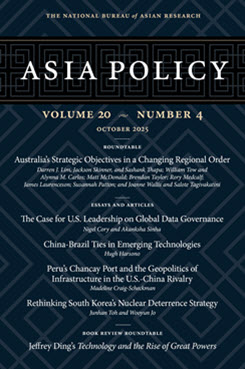Article in Asia Policy 20.4
Rethinking South Korea’s Nuclear Deterrence Strategy
This article assesses South Korea’s options for deterring North Korea beyond nuclear retaliation, focusing on the concept of nuclear latency as a viable alternative.
EXECUTIVE SUMMARY
MAIN ARGUMENT
As North Korea’s nuclear program advances, South Korea faces a strategic dilemma: should it continue to rely on U.S. extended nuclear deterrence or explore alternative deterrence strategies? While South Korea has long depended on the U.S. nuclear umbrella for security, concerns about the credibility of this deterrence mechanism stemming from an uncertain geopolitical environment and North Korea’s accelerating capabilities have led to domestic debates about alternative strategies, including indigenous nuclearization and the reintroduction of U.S. tactical nuclear weapons. Both options, however, pose political and strategic challenges. Instead, enhancing South Korea’s nuclear latency—its ability to rapidly develop nuclear weapons if necessary—is a viable means of strengthening deterrence without violating its nonproliferation commitments. By leveraging its advanced nuclear technology and negotiating greater flexibility in nuclear fuel reprocessing, South Korea can develop a credible deterrent posture that balances alliance commitments with strategic autonomy.
POLICY IMPLICATIONS
- Enhancing nuclear latency would require diplomatic negotiations with the U.S. to revise South Korea’s nuclear agreements, similar to the flexibility granted to Japan in its 123 Agreement with the U.S.
- To be able to go nuclear quickly and enhance deterrence credibility, Seoul would need to make investments in advanced nuclear infrastructure and missile defense systems.
- South Korea must maintain strong regional alliances while carefully managing the risks of escalation and proliferation concerns. Given that policies that loosen nuclear restrictions can be seen to be a stepping stone toward developing an indigenous capability, South Korea must carefully calibrate its intentions and maintain transparency and alignment with the U.S. to avoid being misperceived as moving toward weaponization.
- A well-calibrated deterrence strategy—integrating conventional defense, missile defense, and latent nuclear capabilities—would provide South Korea with more resilient security in the face of North Korea’s growing threats.
Junhan Toh is a Researcher in Politics and International Relations at the University of Sheffield (United Kingdom), where he researches Japanese and South Korean security issues, alliance politics, and international relations in East Asia.
Wooyun Jo is a University Teacher at Loughborough University (United Kingdom). His research interests include international security and international history. He is currently serving as a council member of the Peaceful Unification Advisory Council and as a postgraduate representative for the British International Studies Association War Studies Group. Dr. Jo has published in peer-reviewed journals such as North Korean Review and Defense and Security Analysis. Before turning to academia, he served in the Republic of Korea Army as an officer.
About Asia Policy
Asia Policy is a peer-reviewed scholarly journal presenting policy-relevant academic research on the Asia-Pacific that draws clear and concise conclusions useful to today’s policymakers. Asia Policy is published quarterly in January, April, July, and October and accepts submissions on a rolling basis. Learn more


